lock RENAULT TWINGO 2009 2.G Heating And Air Conditioning - Climate Control Workshop Manual
[x] Cancel search | Manufacturer: RENAULT, Model Year: 2009, Model line: TWINGO, Model: RENAULT TWINGO 2009 2.GPages: 99
Page 6 of 99
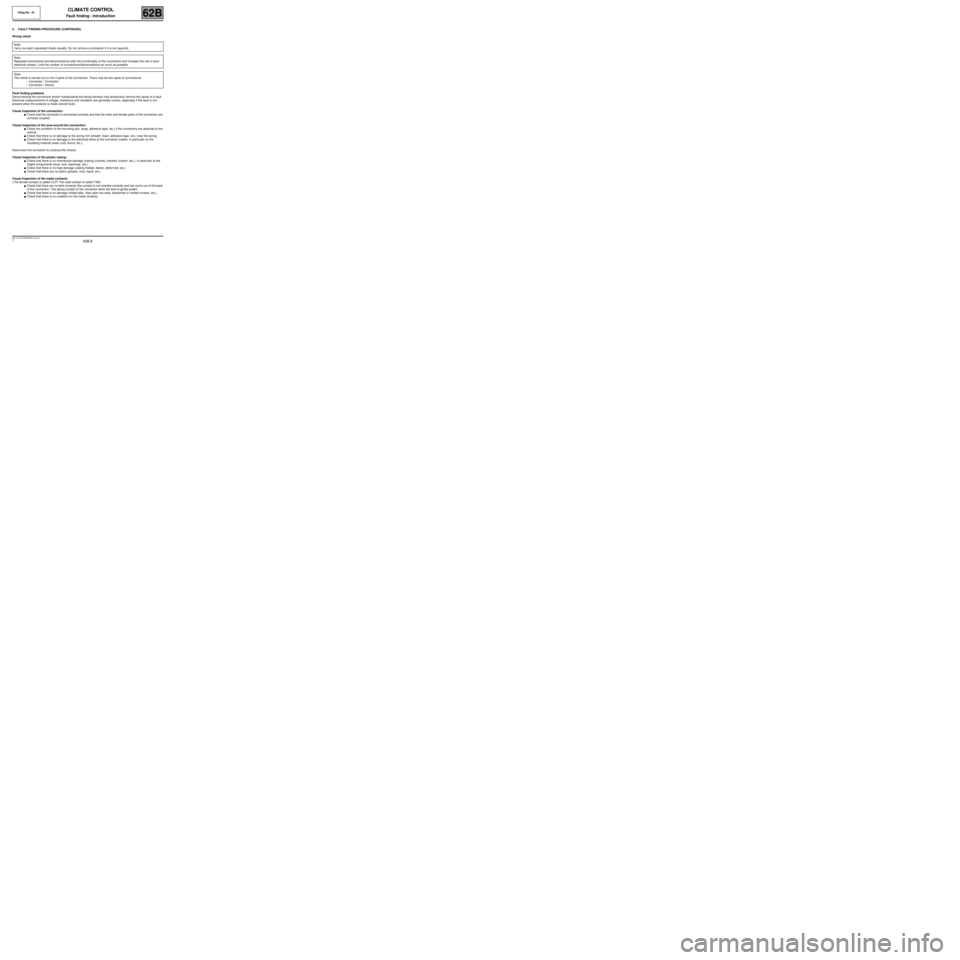
62B-6
MR-413-X44-62B000$046_eng.mif
V1
CLIMATE CONTROL
Fault finding - Introduction
Vdiag No.: 44
62B
4. FAULT FINDING PROCEDURE (CONTINUED)
Wiring check
Fault finding problems
Disconnecting the connectors and/or manipulating the wiring harness may temporarily remove the cause of a fault.
Electrical measurements of voltage, resistance and insulation are generally correct, especially if the fault is not
present when the analysis is made (stored fault).
Visual inspection of the connection:
●Check that the connector is connected correctly and that the male and female parts of the connection are
correctly coupled.
Visual inspection of the area around the connection:
●Check the condition of the mounting (pin, strap, adhesive tape, etc.) if the connectors are attached to the
vehicle.
●Check that there is no damage to the wiring trim (sheath, foam, adhesive tape, etc.) near the wiring.
●Check that there is no damage to the electrical wires at the connector outlets, in particular on the
insulating material (wear, cuts, burns, etc.).
Disconnect the connector to continue the checks.
Visual inspection of the plastic casing:
●Check that there is no mechanical damage (casing crushed, cracked, broken, etc.), in particular to the
fragile components (lever, lock, openings, etc.).
●Check that there is no heat damage (casing melted, darker, deformed, etc.).
●Check that there are no stains (grease, mud, liquid, etc.).
Visual inspection of the metal contacts:
(The female contact is called CLIP. The male contact is called TAB.)
●Check that there are no bent contacts (the contact is not inserted correctly and can come out of the back
of the connector). The spring contact of the connector when the wire is gently pulled.
●Check that there is no damage (folded tabs, clips open too wide, blackened or melted contact, etc.).
●Check that there is no oxidation on the metal contacts. Note:
Carry out each requested check visually. Do not remove a connector if it is not required.
Note:
Repeated connections and disconnections alter the functionality of the connectors and increase the risk of poor
electrical contact. Limit the number of connections/disconnections as much as possible.
Note:
The check is carried out on the 2 parts of the connection. There may be two types of connections:
–Connector / Connector
–Connector / Device
Page 20 of 99
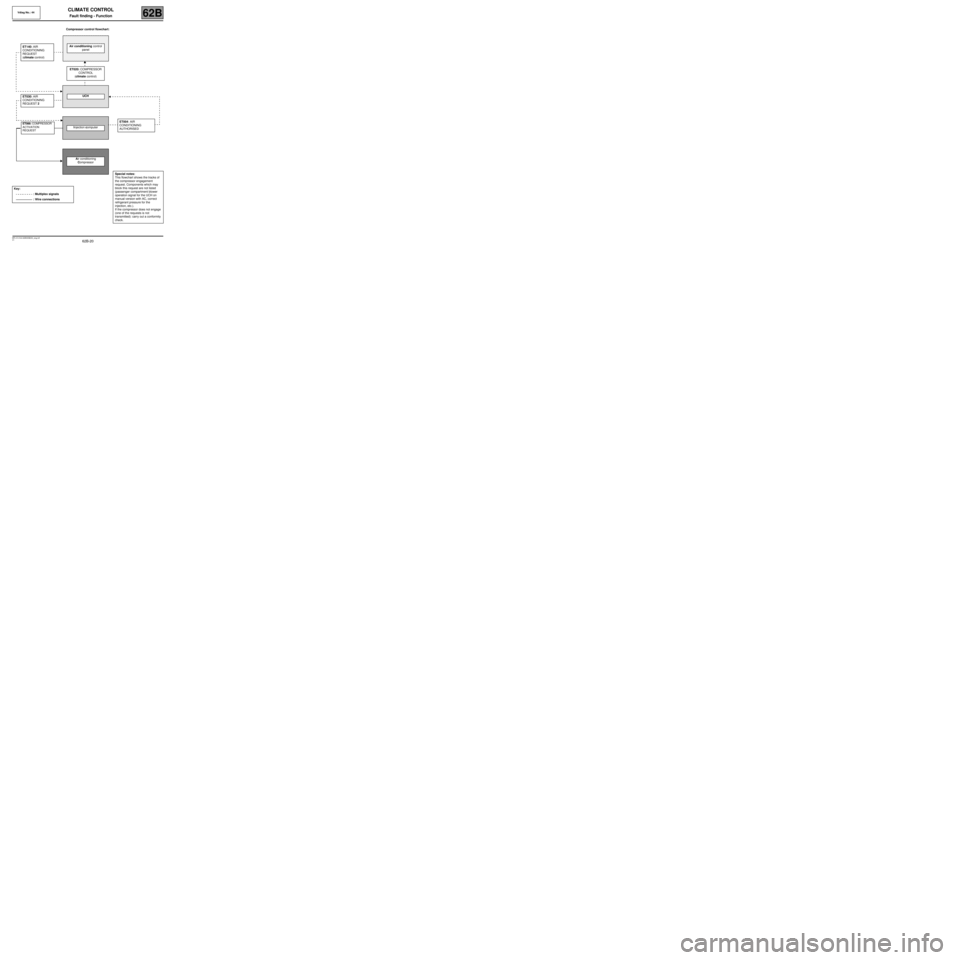
62B-20
MR-413-X44-62B000$230_eng.mif
V1
Vdiag No.: 44CLIMATE CONTROL
Fault finding - Function62B
ET004: AIR
CONDITIONING
AUTHORISED
Special notes:
This flowchart shows the tracks of
the compressor engagement
request. Components which may
block this request are not listed
(passenger compartment blower
operation signal for the UCH on
manual version with AC, correct
refrigerant pressure for the
injection, etc.).
If the compressor does not engage
(one of the requests is not
transmitted): carry out a conformity
check.
Compressor control flowchart:
ET140: AIR
CONDITIONING
REQUEST
(climate control)Air conditioning control
panel
ET020: COMPRESSOR
CONTROL
(climate control)
ET030: AIR
CONDITIONING
REQUEST 2UCH
ET088: COMPRESSOR
ACTIVATION
REQUEST
Injection computer
Air conditioning
Compressor
Key:
: Multiplex signals
: Wire connections
Page 30 of 99

62B-30
MR-413-X44-62B000$414_eng.mif
V1
CLIMATE CONTROL
Fault finding - Interpretation of faults
Vdiag No.: 44
62B
DF012
CONTINUED
With the connector disconnected, measure the resistance value of component 1115 between the following
connections:
●connections S and 38KY,
●connections S and 38LA,
●connections S and 38LB,
●connections S and 38KZ.
If the connection or connections are faulty (see Technical Note 6015A, Repairing electrical wiring, Wiring:
Precautions for repair), repair the wiring, otherwise replace it.
The results of the four checks should be 100 ΩΩ Ω Ω
± 5
ΩΩ Ω Ω
at 20 ˚C, replace the distribution motor if this is not the case.
If the fault is still present, remove the distribution motor but leave it electrically connected, send a motor command
from the distribution buttons on the control panel: switch the distribution setting to demisting (a value of 100 %),
then switch the distribution setting to air vent (a value of 0 %), the motor must change from one direction to the
other. If the connections tested earlier match but the motor does not switch during the commands, replace the
distribution motor.
If the commands have been executed correctly, check that the distribution motor flap is not blocked by trying to
move the gears. Repair if necessary.
If the fault is still present, contact the Techline.
AFTER REPAIRClear the stored faults.
Follow the instructions to confirm repair.
If the motor has been replaced (see Configuration and programming).
Deal with any other faults.
Page 70 of 99
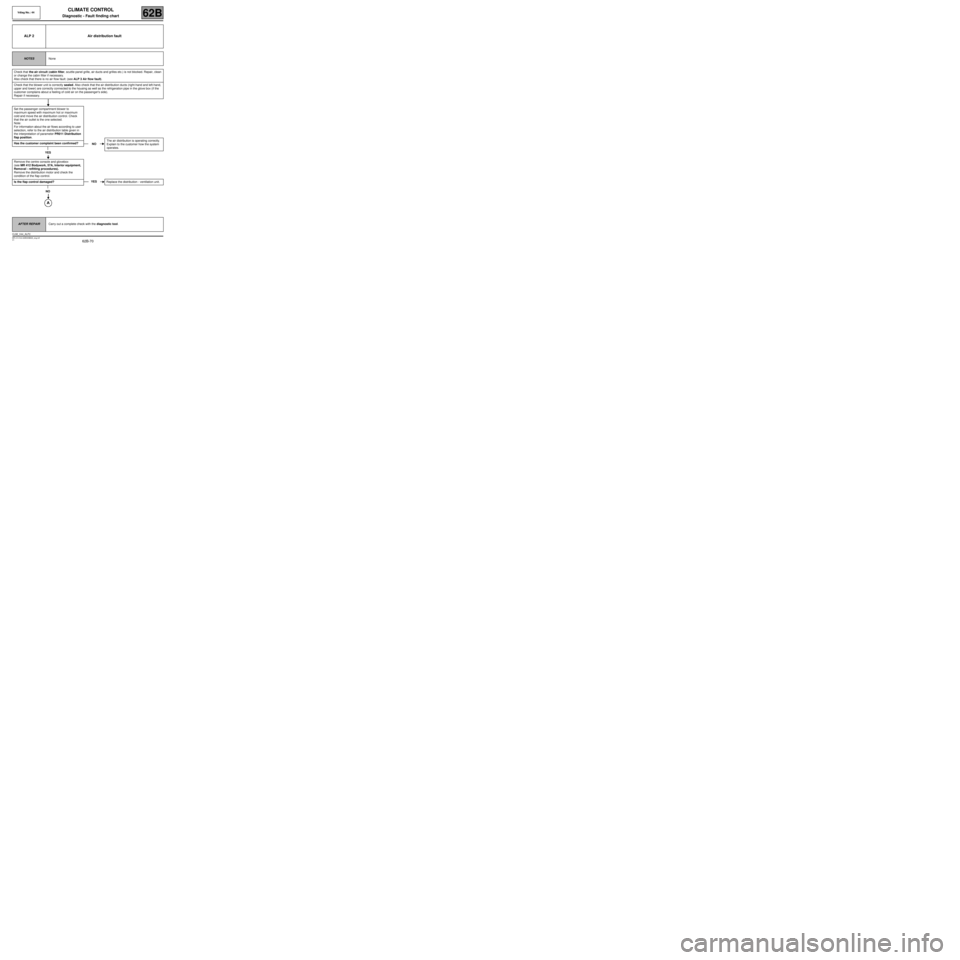
62B-70
MR-413-X44-62B000$828_eng.mif
V1
Vdiag No.: 44CLIMATE CONTROL
Diagnostic - Fault finding chart62B
ALP 2 Air distribution fault
NOTESNone
Check that the air circuit (cabin filter, scuttle panel grille, air ducts and grilles etc.) is not blocked. Repair, clean
or change the cabin filter if necessary.
Also check that there is no air flow fault: (see ALP 3 Air flow fault).
Check that the blower unit is correctly sealed. Also check that the air distribution ducts (right-hand and left-hand,
upper and lower) are correctly connected to the housing as well as the refrigeration pipe in the glove box (if the
customer complains about a feeling of cold air on the passenger's side).
Repair if necessary.
Set the passenger compartment blower to
maximum speed with maximum hot or maximum
cold and move the air distribution control. Check
that the air outlet is the one selected.
Note:
For information about the air flows according to user
selection, refer to the air distribution table given in
the interpretation of parameter PR011 Distribution
flap position.
Has the customer complaint been confirmed?
YES
Remove the centre console and glovebox
(see MR 412 Bodywork, 57A, Interior equipment,
Removal - refitting procedures).
Remove the distribution motor and check the
condition of the flap control.
Is the flap control damaged?
NO
NOThe air distribution is operating correctly.
Explain to the customer how the system
operates.
YES
Replace the distribution - ventilation unit.
AFTER REPAIRCarry out a complete check with the diagnostic tool.
CLIM_V44_ALP2
Page 71 of 99
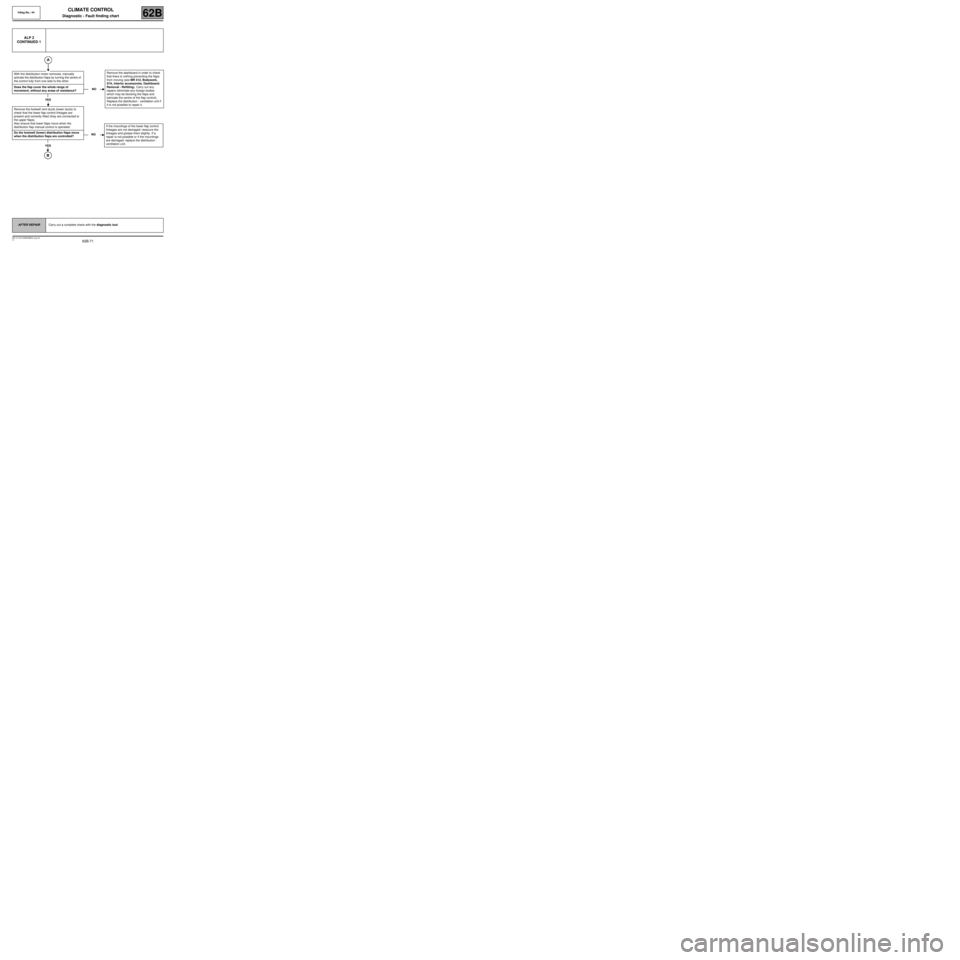
62B-71
MR-413-X44-62B000$828_eng.mif
V1
Vdiag No.: 44CLIMATE CONTROL
Diagnostic - Fault finding chart62B
ALP 2
CONTINUED 1
With the distribution motor removed, manually
activate the distribution flaps by turning the centre of
the control fully from one side to the other.
Does the flap cover the whole range of
movement, without any areas of resistance?
YES
Remove the footwell vent ducts (lower ducts) to
check that the lower flap control linkages are
present and correctly fitted (they are connected to
the upper flaps).
Also ensure that lower flaps move when the
distribution flap manual control is operated.
Do the footwell (lower) distribution flaps move
when the distribution flaps are controlled?
YES
NORemove the dashboard in order to check
that there is nothing preventing the flaps
from moving (see MR 412, Bodywork,
57A, Interior accessories, Dashboard:
Removal - Refitting). Carry out any
repairs (eliminate any foreign bodies
which may be blocking the flaps and
lubricate the centre of the flap control).
Replace the distribution - ventilation unit if
it is not possible to repair it.
NOIf the mountings of the lower flap control
linkages are not damaged: resecure the
linkages and grease them slightly. If a
repair is not possible or if the mountings
are damaged: replace the distribution -
ventilation unit.
AFTER REPAIRCarry out a complete check with the diagnostic tool.
Page 73 of 99
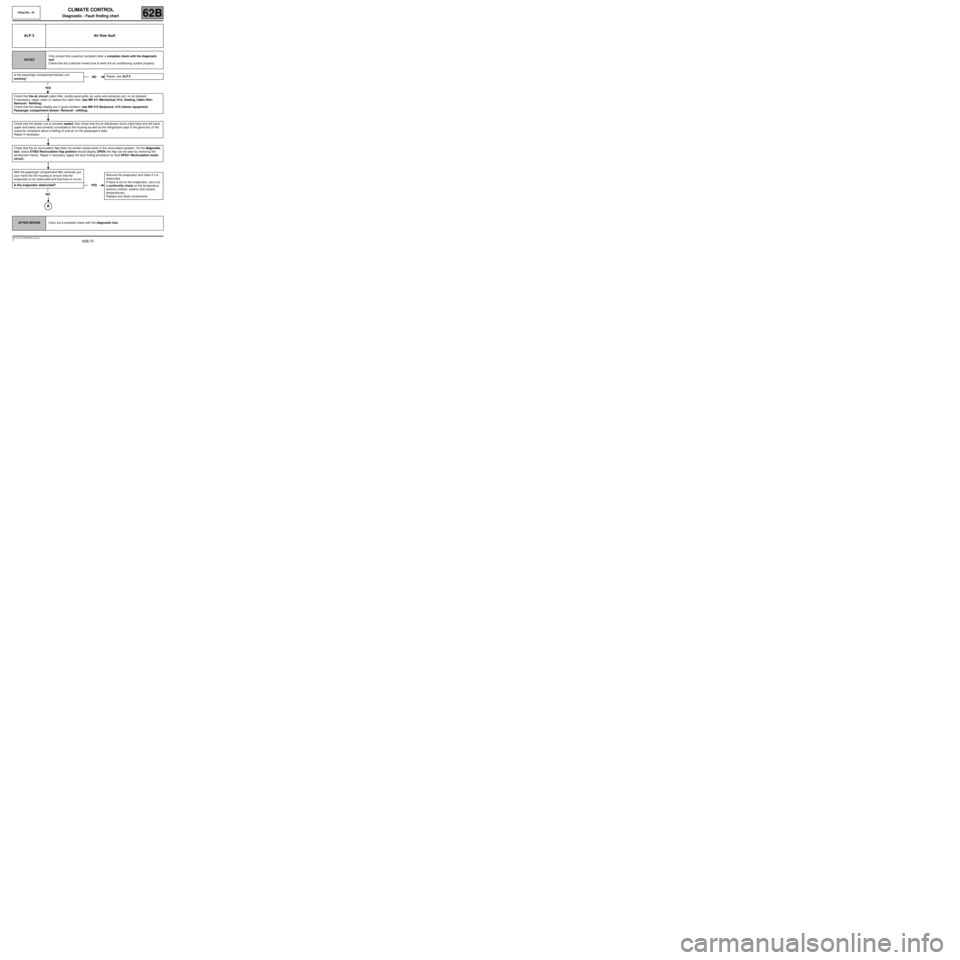
62B-73
MR-413-X44-62B000$828_eng.mif
V1
Vdiag No.: 44CLIMATE CONTROL
Diagnostic - Fault finding chart62B
ALP 3 Air flow fault
NOTESOnly consult this customer complaint after a complete check with the diagnostic
tool.
Check that the customer knows how to work the air conditioning system properly.
Is the passenger compartment blower unit
working?
YES
Check that the air circuit (cabin filter, scuttle panel grille, air vents and extractors etc.) is not blocked.
If necessary, repair, clean or replace the cabin filter (see MR 411 Mechanical, 61A, Heating, Cabin filter:
Removal - Refitting).
Check that the blower blades are in good condition (see MR 412 Bodywork, 57A Interior equipment,
Passenger compartment blower: Removal - refitting).
Check that the blower unit is correctly sealed. Also check that the air distribution ducts (right-hand and left-hand,
upper and lower) are correctly connected to the housing as well as the refrigeration pipe in the glove box (if the
customer complains about a feeling of cold air on the passenger's side).
Repair if necessary.
Check that the air recirculation flap does not remain closed when in the recirculation position. On the diagnostic
tool, status ET062 Recirculation flap position should display OPEN (the flap can be seen by removing the
windscreen frame). Repair if necessary (apply the fault finding procedure for fault DF021 Recirculation motor
circuit).
With the passenger compartment filter removed, put
your hand into the housing to ensure that the
evaporator is not obstructed and that there is no ice.
Is the evaporator obstructed?
NO
NORepair, see ALP 5.
YESRemove the evaporator and clean if it is
obstructed.
If there is ice on the evaporator, carry out
a conformity check on the temperature
sensors (interior, exterior and coolant
temperatures).
Replace any faulty components.
AFTER REPAIRCarry out a complete check with the diagnostic tool.
Page 75 of 99
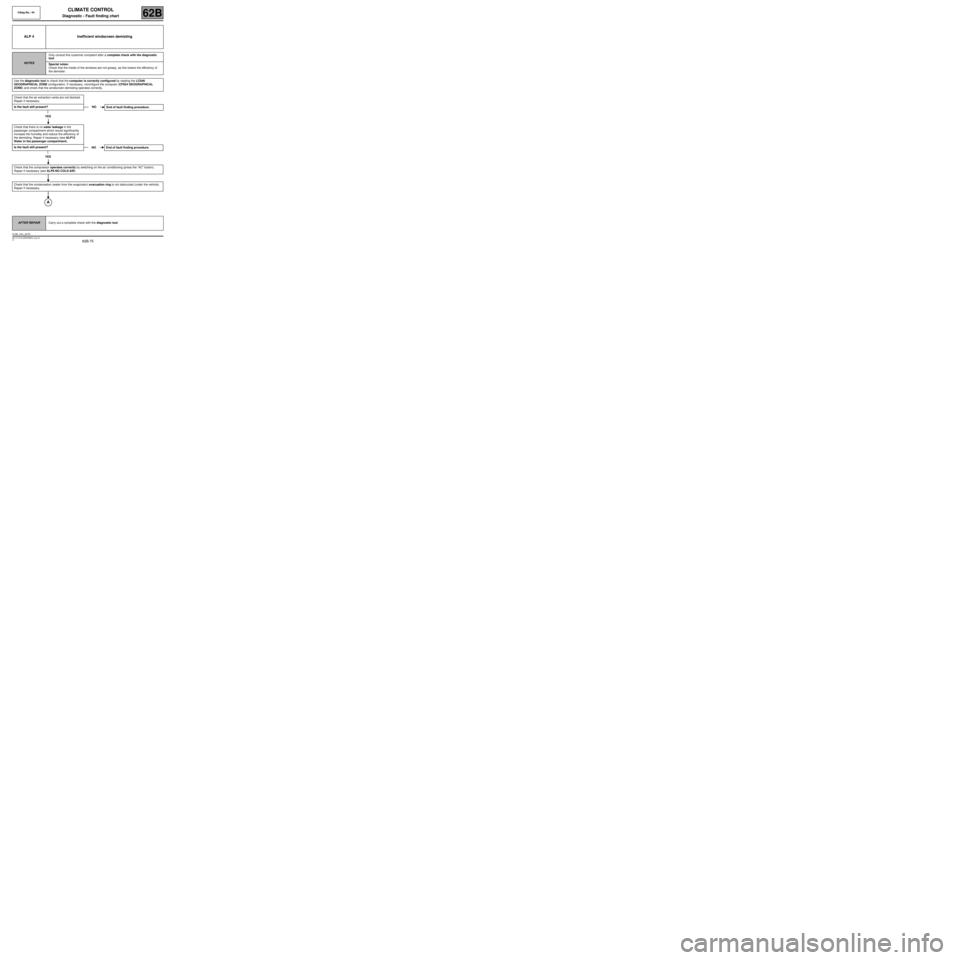
62B-75
MR-413-X44-62B000$828_eng.mif
V1
Vdiag No.: 44CLIMATE CONTROL
Diagnostic - Fault finding chart62B
ALP 4 Inefficient windscreen demisting
NOTESOnly consult this customer complaint after a complete check with the diagnostic
tool.
Special notes:
Check that the inside of the windows are not greasy, as this lowers the efficiency of
the demister.
Use the diagnostic tool to check that the computer is correctly configured by reading the LC046
GEOGRAPHICAL ZONE configuration. If necessary, reconfigure the computer (CF024 GEOGRAPHICAL
ZONE) and check that the windscreen demisting operates correctly.
Check that the air extraction vents are not blocked.
Repair if necessary.
Is the fault still present?
YES
Check that there is no water leakage in the
passenger compartment which would significantly
increase the humidity and reduce the efficiency of
the demisting. Repair if necessary (see ALP12
Water in the passenger compartment).
Is the fault still present?
YES
Check that the compressor operates correctly by switching on the air conditioning (press the “AC” button).
Repair if necessary (see ALP8 NO COLD AIR).
Check that the condensation (water from the evaporator) evacuation ring is not obstructed (under the vehicle).
Repair if necessary.
NO
End of fault finding procedure.
NO End of fault finding procedure.
AFTER REPAIRCarry out a complete check with the diagnostic tool.
CLIM_V44_ALP4
Page 91 of 99
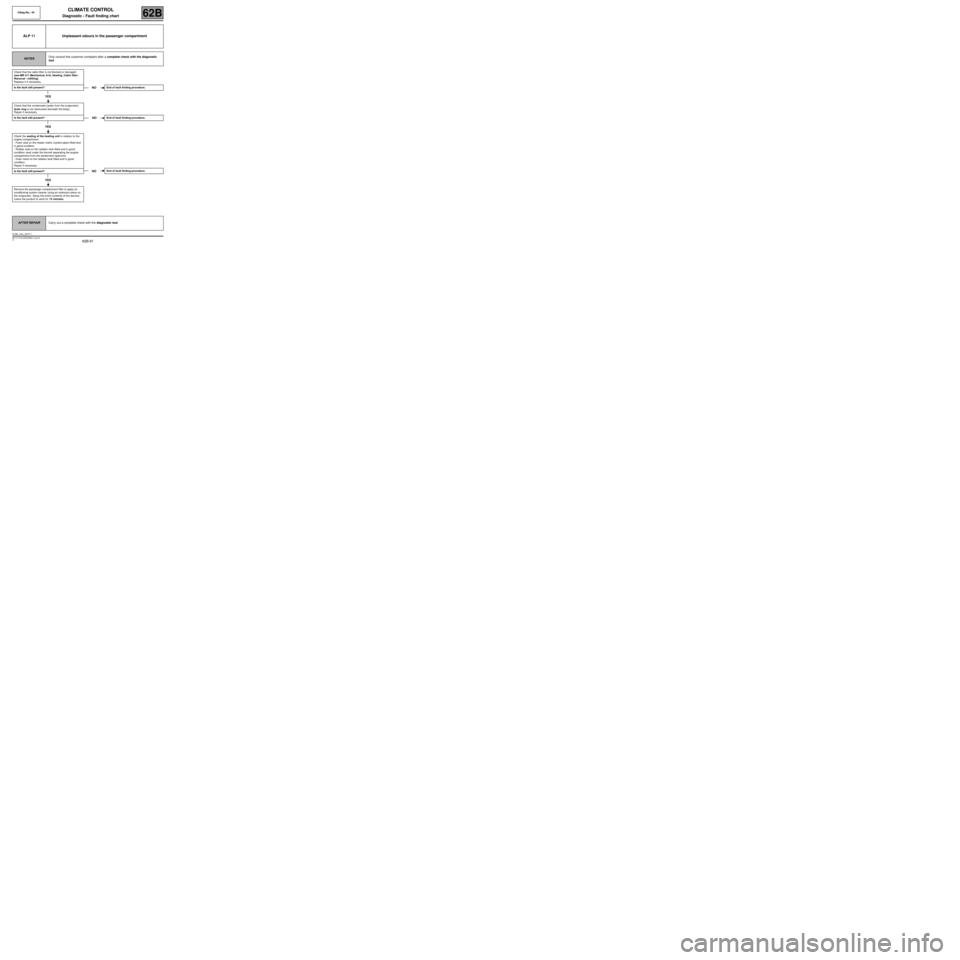
62B-91
MR-413-X44-62B000$920_eng.mif
V1
Vdiag No.: 44CLIMATE CONTROL
Diagnostic - Fault finding chart62B
ALP 11 Unpleasant odours in the passenger compartment
NOTESOnly consult this customer complaint after a complete check with the diagnostic
tool.
Check that the cabin filter is not blocked or damaged
(see MR 411 Mechanical, 61A, Heating, Cabin filter:
Removal - refitting).
Replace it if necessary.
Is the fault still present?
YES
Check that the condensate (water from the evaporator)
drain ring is not obstructed (beneath the body).
Repair if necessary.
Is the fault still present?
YES
Check the sealing of the heating unit in relation to the
engine compartment:
- Foam seal on the heater matrix coolant pipes fitted and
in good condition.
- Rubber seal on the radiator tank fitted and in good
condition (seal under the bonnet separating the engine
compartment from the windscreen aperture).
- Drain valve on the radiator tank fitted and in good
condition.
Repair if necessary.
Is the fault still present?
YES
Remove the passenger compartment filter to apply air
conditioning system cleaner using an extension piece on
the evaporator. Spray the entire contents of the aerosol.
Leave the product to work for 15 minutes.
NOEnd of fault finding procedure.
NOEnd of fault finding procedure.
NOEnd of fault finding procedure.
AFTER REPAIRCarry out a complete check with the diagnostic tool.
CLIM_V44_ALP11
Page 92 of 99
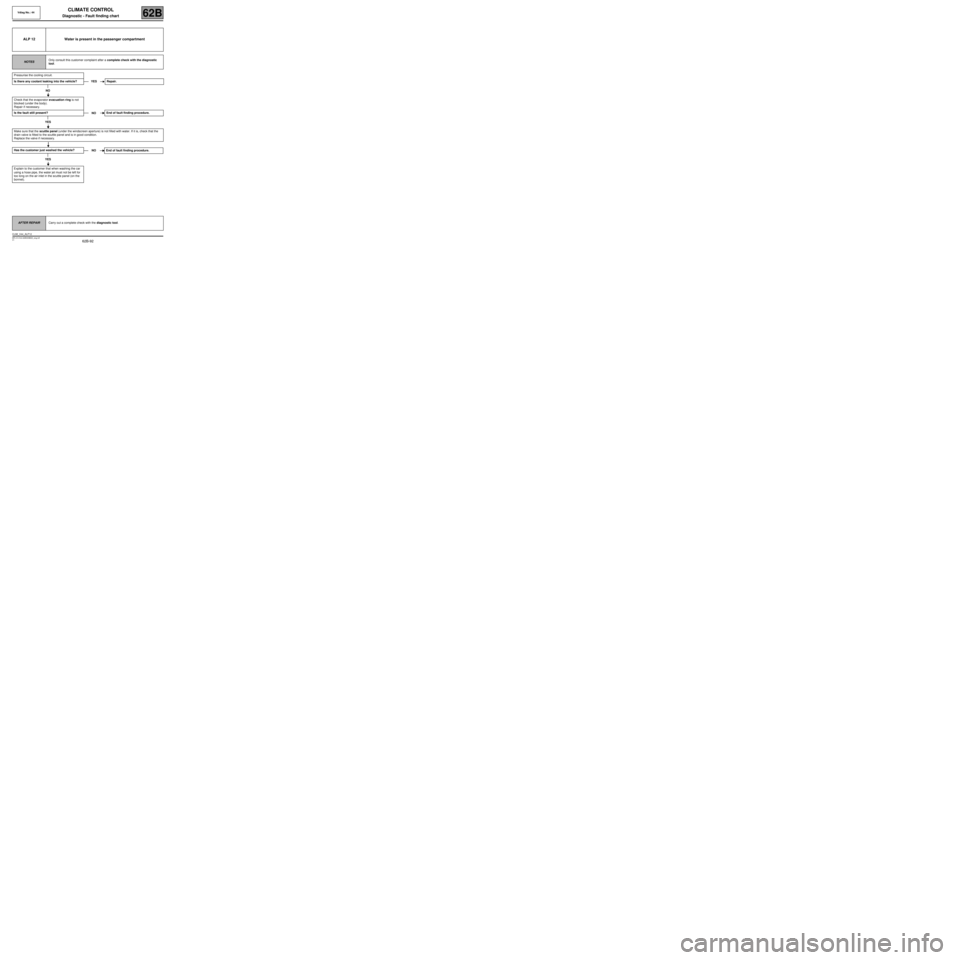
62B-92
MR-413-X44-62B000$920_eng.mif
V1
Vdiag No.: 44CLIMATE CONTROL
Diagnostic - Fault finding chart62B
ALP 12 Water is present in the passenger compartment
NOTESOnly consult this customer complaint after a complete check with the diagnostic
tool.
Pressurise the cooling circuit.
Is there any coolant leaking into the vehicle?
NO
Check that the evaporator evacuation ring is not
blocked (under the body).
Repair if necessary.
Is the fault still present?
YES
Make sure that the scuttle panel (under the windscreen aperture) is not filled with water. If it is, check that the
drain valve is fitted to the scuttle panel and is in good condition.
Replace the valve if necessary.
Has the customer just washed the vehicle?
YES
Explain to the customer that when washing the car
using a hose pipe, the water jet must not be left for
too long on the air inlet in the scuttle panel (on the
bonnet).
YES Repair.
NOEnd of fault finding procedure.
NO End of fault finding procedure.
AFTER REPAIRCarry out a complete check with the diagnostic tool.
CLIM_V44_ALP12